AM General M-998/M-1025 'Humvee' (HMMWV)
Type: High Mobility Multi Purpose Wheeled
Vehicle (HMMWV)
Country of origin: USA
Armor:
Crew: Driver + [M998] 4 Passengers
Air transportability: roll-on/roll-off C-130
Dimensions
Length: 4.573 m (15')
Width: 2.16 m (7.08')
Height: 1.75 m (5.74') ;[M-1025] 1.85 m (6')
Ground clearance:
Weights and loadings
Weight: 2,359 kg (5,190 lb)
Power train
Engine: One 150 bhp General Motors V-8 6.2-liters
fuel-injected diesel, liquid cooled, compression ignition,
at 3,600 rpm, naturally aspirated
Power-to-weight ratio:
Transmission: Allison three-speed, automatic
transmission
Transfer case:
Axles:
Tracks:
Suspension:
Performance
Max land speed: 90 kph (56 mph)
Water speed:
Acceleration:
Range: 563 km (350 mi)
Vertical obstacle:
Trench:
Max fording depth: 0.76 m (2.5')
Gradient: 60%
Side slope: 40%
Turning diameter:
Weapon Systems
Main gun: 12.7 mm M-2 HMG or 60 mm M-5 Light
Mortar or 106 mm M-40-A1 Recoilless rifle
Max effective range: [12.7 mm] 1,800 m
Rate of fire: [12.7 mm] 450 rpm
Ammunition: [12.7 mm] 1,200 rounds
Ammunition type: [12.7 mm] Ball
Rangefinder:
Night gun sight: None
Other defenses:
Variants used: M-998 Cargo/Troop, M-1025
Armament Carrier, M-997 Armored Maxi-Ambulance
Program: Developed by AM General in 1979 and
first entered service in 1985, with about 55,000 Humvees
produced to this date. The High Mobility Multi-purpose
Wheeled Vehicle (HMMWV), popularly called Humvee is the
replacement vehicle for the M-151 series jeeps. Its
primary purpose is to provide a light tactical vehicle
for various purposes and for mounting of various weapons
platforms across all areas of a modern battlefield. The
basic Humvee cost about $56,000, and should not be
confused with the civilian Hummer H1 sold by General
Motors. The AFP initially received about 1,000 HMMWVs
through FMS in the late 80's, and were distributed across
the major commands and the PNP, with most being in use by
the GHQ, the PA and the PMC. Twenty-three units of the
ambulance variant acquired in 2011, which are equipped
with life-support systems to provide immediate medical
response to life-threatening combat casualty personnel
before they are transported to medical treatment
facilities.
Structure: The 4x4 Humvee, the current
world standard in military trucks, is powered by a high-performance
water-cooled diesel engine with a 95 liters (25 gallons)
fuel capacity, Allison three-speed, automatic
transmission, four wheel drive, power-steering with a two-speed,
locking, chain driven transfer case. Brakes are of
hydraulic four-wheeled disc type and the engine fan is of
clutch-type, engine-driven. The Humvee is both air-transportable
and air-droppable from different type of fixed-wing and
rotary-wing aircraft. Electrical system consist of 24V 60A,
negative ground-type. Depending on the model, the Humvee
can be equipped with a self-recovery winch capable of
supporting payloads up to 2,000 kg (4,400 lb), and a 2,727
kg (6,000 lb) 1:1 ratio line pull capacity and
supplemental armor plating. The AFP uses several variants
- the M-1025/M-1026/M-1043 HMMWVs, Armament Carrier
configuration, which re equipped with basic armor and a
variety of weapons mount, located on the roof of the
vehicle, either the M-60 7.62 mm machine-gun, the M-2 .50
caliber machine-gun, the Mk. 19 grenade launcher or the M-5
81 mm mortar. The weapons platform can be traversed 360°.
It can also carry communications equipment instead of
various weapons systems. The Humvee can climb 60% slopes
and traverse a side slope of up to 40% fully loaded. The
vehicles can ford hard bottom water crossing up to 0.76
meters without a deep water fording kit. The other
versions, M-998/M-1038 Humvee are Cargo/Troop carrier and
are used to transport equipment, materials, and/or
personnel with a payload (including crew) of 1,136 kg (2,500
lb) and the troop carrier is capable of transporting a
two man crew and eight passengers. Both use a troop seat
kit for troop transport operations. The cargo/troop
carrier can also be configured in a four man crew
configuration. Though successful as a troop transport, it
was never designed to be an APC, thereby it offers its
passengers very little protection from small-arms fire.
Foreign field reports indicate that additional improvised
armor may do more harm than good for it strains the
suspension and drivetrain components by the added weight.
Modernization: Some Marine units sports
improvised armor of various configurations from
decommissioned LVTP-5s.
  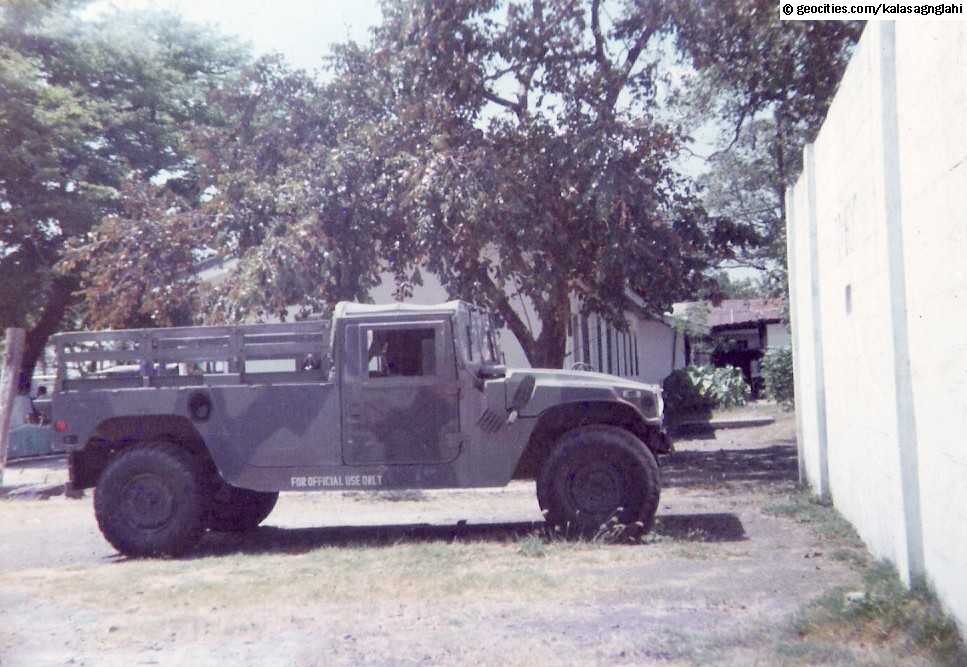
Two photos of M-998
HMMWV, the left one is a Marine "hardened"
Humvee version. Thanks to Manokski
for the
pic and info.
Back to top
Ford/ AM General M-151A1C 'Kennedy'
4x4 Recoilless Rifle Carrier Jeep
Type: Multi Utility Tactical Truck (MUTT)
Country of origin: USA
Armor: None
Crew: Driver + 3 Passengers
Air transportability: roll-on/roll-off C-130
Dimensions
Length: 3.38 m (11.09')
Width: 1.62 m (5.31')
Height: 1.8 m (5.9') [top up]; 1.35 m (4.43')
Ground clearance:
Weights and loadings
Weight: 1,070 kg (2,400 lb)
Power train
Engine: One 71 hp (52 kW) 4-cylcle engine 2,320
cc at 4000 rpm
Power-to-weight ratio:
Transmission:
Transfer case:
Axles:
Tracks:
Suspension: Independent swing axle rear
suspension with coil springs [A1]; Semi-trailing arm
suspension with coil springs [A2]
Performance
Max land speed: 442 km (275 mph)
Water speed:
Acceleration:
Range:
Vertical obstacle:
Trench:
Max fording depth:
Gradient:
Side slope:
Turning diameter:
Weapon Systems
Main gun: 12.7 mm HMG or M-40-A1 106 mm
Recoilless Rifle
Max effective range: 1,800 m [12.7 mm]
Rate of fire: 450 rpm [12.7 mm]
Ammunition: 1,200 rounds [12.7 mm]; 6 rounds [M-40]
Ammunition type: [12.7 mm] Ball
Rangefinder: .50 cal spotting rifle [M-40-A1]
Night gun sight:
Variants used: Utility, RR carrier, MG carrier,
Ambulance, Mobile Communications
Program: In 1951 Ford Motor Company was awarded
the contract to design a ¼ ton 4x4 Multi-Utility
Tactical Truck (MUTT) to replace the M-38 and M-38A1
model jeeps. The M-151 was developed with guidance from
the US Army's Ordnance Truck Automotive Command. Design
started in 1951, production from 1959 through 1982 and
served in the Vietnam War and up to the late 90's.
Although the M-151 was developed and initially produced
by Ford, production contracts for the M-151A2 were later
also awarded to Kaiser Jeep and AM General Corp.
Although the M151 mostly retained the same basic layout
and dimensions of its predecessors, it was for all
intents and purposes a completely new design. Unlike
previous jeep designs, whose structure consisted of a
steel tub bolted onto a separate steel frame, the M151
utilized a monocoque design, which integrated the box
frame rails into the sheet-steel body-structure.
Eliminating the separate frame gave the M-151 slightly
more ground clearance, while at the same time lowering
the center of gravity. This process slightly enlarged the
vehicle, making it roomier than previous jeep designs,
while retaining the same light weight.
Another area improved upon in the M151 was the suspension.
Dispensing with the rigid live axles in the front and
rear that all previous military jeeps used (a layout
still used on modern day Jeeps, such as the Jeep CJ and
Wrangler prior to the 1997 TJ), the M-151 was instead
equipped with independent suspension and coil springs.
This made it capable of high-speed, cross-country travel,
while boasting high maneuverability and agility. The new
suspension also had the added benefit of providing a more
comfortable ride. At high road speed, the rear suspension
in a lightly loaded MUTT had a tendency to tuck under the
vehicle during turns, causing it to roll. The vehicle's
tendency to roll over was reduced when there was weight
in the rear, so drivers would often place an ammunition
box filled with sand under the rear seat when no other
load was being carried. The box could simply be emptied
or abandoned when the extra weight was not needed.
Due to copyright and trademark issues, the M-151 did not
feature Jeep's distinctive seven vertical slot grille,
instead, a horizontal grille was used.
Versions: M151 (1960) Initial version. Because of its
rear suspension design it had a dangerous tendency to
flip over when cornered too aggressively by unaware
drivers. The coil spring and swing-axle rear suspension
lay-out (similar to the rear suspension of the VW Beetle)
could result in big rear wheel camber changes, causing
drastic oversteer and a subsequent roll-over. M151A1 (1964)
Second version. minor changes in the rear suspension,
mostly aimed at allowing the vehicle to carry heavier
loads. Addition of turn signals to front fenders. The
essentials of the rear suspension remained unchanged and
the same applies to the handling problems in corners. The
M151A1C equipped with a 106 mm recoilless rifle on a
pedestal-mount. Capable of carrying six rounds of
ammunition and weapon tools. Including the driver, it
provides space for two men. M718, Front-line ambulance
variant. M151A2 (1970), the A2 fielded a significantly
revised rear suspension that greatly improved safety in
fast cornering. The MUTT now had Semi-trailing arm
suspension comparable to what most late 80's premium
German cars had. Many smaller upgrades including improved
turn signals. The A2 can be identified by the large
combination turn signal/blackout lights on the front
fenders, which also had been modified to mount the larger
lights, as opposed to earlier A1's that had flat front
fenders. Continuing problems with vehicle roll-overs into
the 1980s led the US military to retrofit many M151
series vehicles with the "Roll over protection
structure" (ROPS), a roll cage intended to protect
both front and rear seat passengers.
The M-151 jeep is one of the workhorse utility vehicles
of the AFP, received through FMS, from surplus US stocks,
initially gasoline-powered, but converted to diesels by
the Logistics Command, it is sometimes armed with a
variety of machine-gun mounts, it can also carry the M-40-A1
106 mm recoilless rifle on a M-79 rifle mount to support
infantry units against hardened targets such as bunkers
and hostile APCs. It has a magazine fed .50 caliber
spotting gun attached to aid in aiming the weapon. The
weapon can be depressed at -11° and elevated to +11°.
The M-151 is also capable of carrying communications
equipment to provide C² over field units. It may carry
any of the following all-weather, all-terrain radios -
VHF/AM (Air traffic control communication transceiver);
UHF/AM (Military tactical communication transceiver); VHF/AM
(air-to-ground communications transceiver URC-777 with
AMP 50-RF booster); HF/SSB (Single sideband
communications transceiver URC-187 with LA-100-RF booster).
Power supply for the communications gear is a Vetronix PS-20C,
with an auxiliary power unit gas-driven, air-cooled
generator supplying 4 kW.
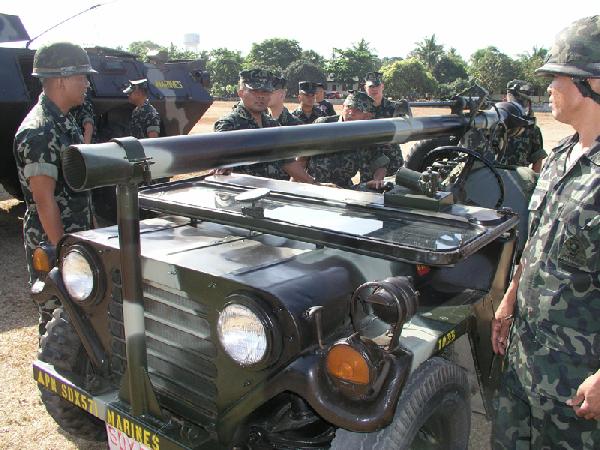  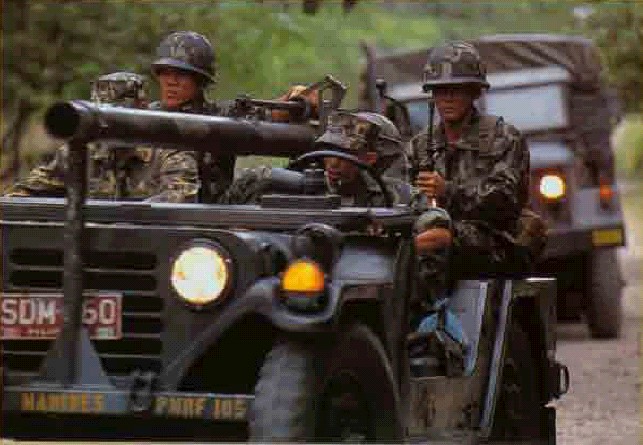
Photos of Marine M-151
jeeps sporting M-40-A1 106 mm recoilless rifle.
Back to top
KIA
M-450 4x4
Type: Light Utility Vehicle
Country of origin: South Korea
Crew: Driver + 13 Infantry
Air transportability: roll-on/roll-off C-130
Dimensions
Length: 5.4 m (17.72')
Width: 2.18 m (7.15')
Height: 2.5 m (8.2')
Ground clearance:
Weights and loadings
Weight: 3.1 tons
Power train
Engine: One 139 hp D4DA diesel engine
Power-to-weight ratio:
Transmission: Manual
Transfer case:
Axles:
Tracks:
Suspension:
Performance
Max land speed: 105 kph (64.62 mph)
Water speed:
Acceleration:
Range: 880 km (546.81 mi)
Vertical obstacle: ~0.5 m (1.64')
Trench: ~0.5 m (1.64')
Max fording depth: 0.76 m (2.49')
Gradient: 60%
Side slope: 40%
Turning diameter:
Weapon Systems
Main gun:
Max effective range:
Rate of fire:
Ammunition:
Ammunition type:
Rangefinder:
Night gun sight:
Variants used:
Program: The Kia KM-450 is a light 4x4 multi-purpose
all-terrain military truck. It is a modern license-produced
version of the US M-715 (designed in the mid-1960s).
Despite similar appearance to the M-715, the KM-450
series trucks are different in a number of areas,
including mechanical systems. The Kia KM450 military
truck features a sturdy full grille guard to protect the
front from damage. The KM-450 was first introduced in
1998. This military vehicle is in service with ROK Army
and has been exported to some countries. The baseline
version is a troop/cargo carrier. It offers substantially
more room and hauling capacity, than the smaller Kia KM-420.
This military vehicle has a payload capacity of 1,530 kg
on hard surface roads and 1,330 kg on cross-country
terrain. It can also tow light trailers or artillery
pieces. The cab of the KM-450 accommodates a driver and
one passenger. It has an open top, covered with canvas
cover. The windshield can be folded down for added combat
versatility. The slated cargo body walls also serve as
troop seats when folded down, accommodating up to 12
fully-armed troops. Troop/cargo area is covered with
removable bows and canvas cover. Can be fitted with a
basic armor kit. The AFP acquired 651 units KIA M-450 1
¼ ton troop carriers from Hyundai Corp. and KIA Motors
of South Korea for Php 1,421.855 million, with the first
delivery on December 2007, all with Integrated Logistics
support.
Back to top
Willys-Overland/
Ford Motor Corp. MB Jeep 4x4
Type: Light Utility Vehicle
Country of origin: USA
Crew: Driver + 3 Infantry
Air transportability: roll-on/roll-off C-130
Dimensions
Length: 3.3 m (10.83')
Width: 1.57 m (5.17')
Height: 1.32 m (4.33')
Ground clearance:
Weights and loadings
Weight: 1,400 kg (3,086 lb)
Power train
Engine: One 60 hp (45 kW) Four cylinder, 2,200
cc engine at 4,000 rpm
Power-to-weight ratio:
Transmission: 3-speed + reverse T-84
transmission
Transfer case: 2-speed Model 18 transfer case
Axles:
Tracks:
Suspension:
Performance
Max land speed: 104 kph (65 mph)
Water speed:
Acceleration:
Range: 485 km (301 mi)
Vertical obstacle:
Trench:
Max fording depth:
Gradient:
Side slope:
Turning diameter:
Weapon Systems
Main gun:
Max effective range:
Rate of fire:
Ammunition:
Ammunition type:
Rangefinder:
Night gun sight:
Variants used:
Program:
Back to top
KIA
M-250 6x6 Truck
Type: Light Utility Truck
Country of origin: South Korea
Crew: Driver + 20 Infantry
Air transportability: roll-on/roll-off C-130
Dimensions
Length: 6.78 m (22.24')
Width: 2.43 m (7.97')
Height: 2.84 m (9.32')
Ground clearance:
Weights and loadings
Weight: 6.17 tons
Power train
Engine: One 180 hp KK-7.4 diesel engine
Power-to-weight ratio:
Transmission:
Transfer case:
Axles:
Tracks:
Suspension:
Performance
Max land speed: 95 kph (59 mph)
Water speed:
Acceleration:
Range: 955 km (593.41 mi)
Vertical obstacle:
Trench:
Max fording depth: 0.76 m (2.49')
Gradient: 60%
Side slope:
Turning diameter:
Weapon Systems
Main gun:
Max effective range:
Rate of fire:
Ammunition:
Ammunition type:
Rangefinder:
Night gun sight:
Variants used:
Program: The KM-250 is a baseline model for Kia's
6x6 tactical truck series. It is an updated US M-35A2
truck, produced by the Kia Motors. Vehicle retains a
classic American military truck appearance with the long
bonnet, spartan soft-topped cab, and a large carrying
area. It is in service with the ROK Army. The KM-250 has
a payload capacity of 2,270 kg off road and 4,550 kg on
hard surface roads. It can carry up to 20 fully equipped
troops, plus the crew of two. The removable slated body
walls serve as troop seats when folded down. The canvas
top and supporting structure can be removed from both the
cab and cargo body. The windshield can be also folded for
maximum versatility. This South Korean military truck is
also used to tow trailers or artillery pieces, such as
the 105-mm field howitzer. On December 2010, the AFP has
received a total of 20 units (out of the 250 total for
both PA and PAF) M-250 2 ½ ton Troop Carriers with the
second batch of 115 units are scheduled to arrive January
2011, the third batch of 115 units on February 2011, all
with Integrated Logistics support.
Back to top
REO
Motor Car Co./ AM General/ Kaiser M-35A2 6x6 Truck
Type: Armed 6x6 Utility Vehicle
Country of origin: USA
Armor: Rolled homogenous steel plates (PMC
guntrucks only)
Crew: Driver + ? Infantry
Air transportability: roll-on/roll-off C-130
Dimensions
Length: 7 m (22.97')
Width: 2.4 m (7.87')
Height: 2.84 m (9.32')
Ground clearance:
Weights and loadings
Weight, empty: 5,910 kg (13,029 lb)
Power train
Engine: One 130 hp LDS-465-1 Multifuel turbo
engine
Power-to-weight ratio:
Transmission: 5-speed manual transmission
Transfer case: Divorced 2-speed transfer case
Axles:
Tracks:
Suspension:
Performance
Max land speed: 88.51kph (55 mph)
Water speed:
Acceleration:
Range: 724 km (450 mi)
Vertical obstacle:
Trench:
Max fording depth:
Gradient:
Side slope:
Turning diameter:
Weapon Systems
Main gun: 12.7 mm HMG
Max effective range: 1,800 m
Rate of fire: 450 rpm
Ammunition: 1,200 rounds
Ammunition type: Ball
Rangefinder: Optical
Night gun sight: None
Variants used: Command carrier, Dump truck,
Water carrier, Vehicle Recovery
Program: Thousands of M-35 6x6 trucks (and
variants) were received through FMS from surplus US
stocks and serve as general transports through the years.
Recent acquisitions includes 300 units M-35A2, accepted
on 30 June 2000 through grant from US EDA. The M-35
started out in 1949 as a design by the REO Motor Car
Company as a 2 ½ ton truck that was later nicknamed the
deuce and a half. The first vehicle in the family, the M-34,
was quickly superseded in military usage by the M-35, the
major difference being the M-35's 10-tire configuration
versus the M-34's 6-tire "super-singles"
configuration. The M-35 has a payload capacity of 2,300
kg off road and 4,500 kg on hard surface roads. The
standard wheelbase cargo bed is 2.4 m by 3.6 m (8' x 12').
The M-35A2 is available with a canvas soft top.
The gasoline-powered deuces were built primarily by REO
Motors, however, Studebaker also had a manufacturing
contract from at least 1951 up into the early 1960s.
Curtis-Wright also had a contract in at least 1958 to
build deuce dump trucks with the Continental gas engine.
The A1's had Continental LDS-427-2 non-turbo, and 5th
gear was an overdrive. The engines were not reliable nor
powerful. A2 trucks received the LDS-465-1 Multifuel
turbo engines, keeping the OD transmission of the A1s.
Through the years the trucks were upgraded to LDT (turbo
clean air)-465-1A, B, C. The turbo was added more to
clean up the very black exhaust on the Non Turbo engines,
than to add power, the HP was only raised from 130 to 135
HP. The LDT-465 D was the last version of the Multi Fuel,
it had a Quieter Turbo (non whistler) better head gasket
sealing and head cooling.
Brake system is air-assisted-hydraulic six wheel drum
with a driveline parking brake, although gladhands exist
on the rear of the vehicle for connection to trailers
with full air service and emergency brakes. Braking
performance of the truck is similar to other power drum
brake vehicles of this size. Each drum was designed with
maximum efficiency in mind, and individual drums can
dissipate up to 16 hp (12 kW) of braking heat. Due to
this brake system and GVWR under 11,794 kg (26,001 lb),
the big deuce can be driven without a commercial driver's
license in most states. Even California does NOT require
a CDL to operate an M-35 on public roads because even
though it has three axles and an air-assisted braking
system, the maximum gross weight is still under 12,000 kg
(26,000 lb), making it eligible for class C on-road
driving; and because the primary braking system is
hydraulic, not air. The electrical system is 24 V, using
two 12 V 6TL-series military grade batteries run in
series. Some deuces are equipped with a 4,500 kg (10,000
lb) PTO-driven front winch manufactured by Garwood.
The curb weight of an M35 is between 5,900 kg (13,000 lb)
and 7,300 kg (16,000 lb) empty, depending on
configuration (cargo, wrecker, tractor, etc.). Its top
speed is 90 kph (56 mph), though maximum cruising speed
is approximately 77 kph (48 mph). Fuel economy is 11 mpg-US
(21 L/100 km; 13 mpg-imp) highway and 8 mpg-US (29 L/100
km; 9.6 mpg-imp) city, giving the deuce a 600–800 km
(400-500-mile) range on its 190 L (50 US gallons; 42 Imp
gal) single fuel tank.
The PMC's 6th Marine Battalion Landing Team initially
converted a 2 ½ M-35 truck, which was uparmored with add-on
armor from salvaged hull plates from decommissioned LVTP-5,
thereby creating a hardened and protected convoy vehicle
dubbed as "Talisman". As it was successful in
saving infantry's lives in the field, the PMC started
hardening of fifteen other M-35 trucks to serve as
additional armored transports in the South. Unlike the
prototype Guntruck, the armor of the new Guntrucks are
brand new and are not salvaged from the old LVTP-5s, also
they are welded or bolted in place. The two-layer armor
can withstand up to 7.62 mm ball and AP ammunition. The
armor configurations vary and are usually located in the
side and the rear with the top left open. Machine-guns
can be mounted along the sides of the truck. The PMC
plans to deploy about two Guntrucks to each deployed
Marine battalion. The PMC plans to deploy about two
Guntrucks per deployed Marine battalion.
The PMC had also begun the creation of an anti-aircraft
unit by 2006, utilizing M-35 based vehicles. Two types of
vehicles have been seen so far. One utilizes the Mk 51
tub mount from the decommissioned Swift Mk.1 boats, with
two M2 Browning 12.7 mm HMG, while the other features
another former naval mount, a single Oerlikon 20 mm
cannon.
  
Photos of a Marine M-35
"hardened" Guntrucks, notice the different
armor configurations. Thanks to Manokski
and mblt6
for the pic and info.
Back to top
GKN Defence Limited Aquatrack (LCP)
Type: Amphibious Vehicle (LCP)
Country of origin: United Kingdom
Armor:
Crew: 2
Air transportability:
Dimensions
Length: 9.21 m (30.22')
Width: 3.20 m (10.5')
Height: 3.15 m (10.33')
Ground clearance:
Weights and loadings
Weight:
Power train
Engine: 1 x 315 bhp Deutz BF8L513 diesel; 2 CP
props
Power-to-weight ratio:
Transmission:
Transfer case:
Axles:
Tracks:
Suspension:
Performance
Max Land Speed: 40 kph
Water speed:
Acceleration:
Range: 500 km
Vertical obstacle:
Trench:
Max fording depth:
Gradient:
Side slope:
Turning diameter:
Weapon Systems
Main gun:
Max effective range:
Rate of fire:
Ammunition:
Ammunition type:
Rangefinder:
Night gun sight:
Variants used:
Program: Designed and produced by GKN Limited,
actually owned by the DND, Office of Civil Defense (OCD),
these tracked, amphibious vehicles are operated the PMC
for Mt. Pinatubo Rescue Team, and are utilized for
disaster relief operations throughout the country. They
are designed to transport payloads from off-shore vessels.
The design of the tracks are derived from the US Army's
MRLS, and is equipped with a propeller for increased
water speed. Running gear duplicates that of an M-113 APC
and the tracks contribute to afloat propulsion. Able to
beach through 3 m seas. Can operate in Sea State 5. Has a
4.3 x 2.6 m open cargo deck and stern ramp aft capable of
carrying 5 tons of cargo or a light truck.
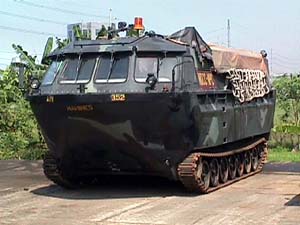  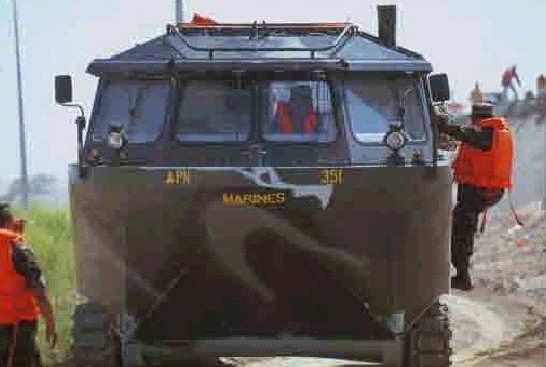
Photos of the DND-OCD
Aquatrack, utilized by the PMC.
Back to top
LARC-V (Light, Amphibious, Resupply,
Cargo Vehicle)
Type: 4x4 Amphibious Vehicle
Country of origin:
Armor: Serrated aluminum
Crew:
Air transportability:
Dimensions:
Length: 19.21 m (63')
Width: 8.23 (27')
Height:
Ground clearance:
Weights and loadings
Weight: 37,000 kg (81,400 lb)
Power train
Engine:
Power-to-weight ratio:
Transmission:
Transfer case:
Axles:
Tracks:
Suspension:
Performance
Max land speed: 50 kph (31 mph)
Water speed: 15 kph (9 mph)
Acceleration:
Range at land, with 60-T payload, at 23 kph (14 mph):
241 km (150 mi)
Range at water, with 60-T payload, at 6 knts: 75
nm
Vertical obstacle:
Trench:
Max fording depth:
Gradient:
Side slope:
Turning diameter:
Weapon Systems
Main gun:
Max effective range:
Rate of fire:
Ammunition:
Ammunition type:
Rangefinder:
Night gun sight:
Program: Basically having the same function as
GKN's Aquatrack, though it has a larger capacity and runs
on wheels. The PMC operates this vehicle usually for
disaster relief operations throughout the country.
Payload is 60 tons. Recently the PMC has made two LARC-V's
operational to support the uparmored LVTH-6s in its
inventory by carrying its additional ammunition
requirements during amphibious operations with a third
unit said to be operational by September 2006.
 
Photos of the LARC
used by the Marines..
Back to
top
Last
modified on 11/07/11

|








